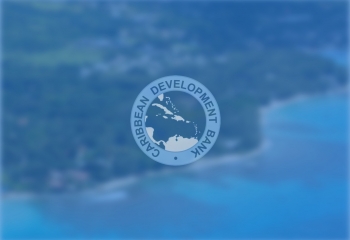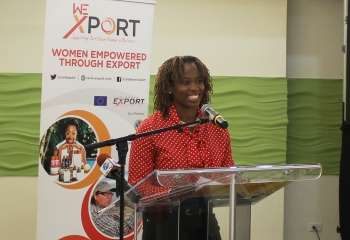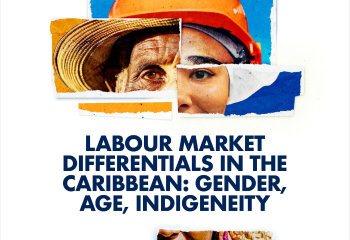Keynote- Energy Transition Imperatives for the Caribbean: Post COP26 Reflections
Salutations
Good morning, Distinguished Presenters and Participants.
Let me begin by commending the New Energy Events and sponsors of the Caribbean Renewable Energy Forum (CREF) for staging yet another critical event where key stakeholders (policymakers, regulators, utilities, investors, developers and financiers) can strategise on how best we could collectively accelerate the energy transition which is so critical for the sustainable development of the Caribbean region and the global community at large.
I want to start with a bold statement that there can be no sustainable development without sustainable energy. To embed sustainable energy in a way that can be transformative, our focus must also be on democratising energy such that we are not just focused on substituting one energy technology for another but more importantly on ensuring that our households, citizens, and communities are directly involved in integrated energy services solutions that can directly impact their living conditions and the welfare of their communities.
Today, I want to use this opportunity, the first in-person edition of the Forum in two years, to share my thoughts with you on:
- The critical connection between sustainable energy and sustainable development.
- Energy transition challenges and opportunities in the region against the backdrop of the COP26, the Covid-19 pandemic, and the on-going Ukraine-Russia Crisis.
I will then propose a key initiative that could advance energy transition in the Caribbean region and identify some key considerations for financing the transition.
Sustainable Energy and Sustainable Development
Energy is a vital input in all economic activity and, as former United Nations Secretary-General, Ban Ki-Moon, put it, is the “golden thread that connects economic growth, social equity, and environmental sustainability”. For us at the Caribbean Development Bank, sustainable development is about improving the capabilities of the peoples of our Region by raising their standard of living, self-esteem, and confidence, and imbuing them with freedom of choice.
To do so, our development effort must seek to advance growth of the ecosystem. This requires a focus on all aspects of resilience (social, institutional, production capacity, environmental, and financial resilience), and to follow the quote from the former UNSG Ban Ki-Moon, sustainable energy must be at the center of building a resilient and sustainable ecosystem.
In the context of sustainable energy, our focus must be on how we attain the objectives enshrined in SDG7 of the 2030 Agenda for Sustainable Development which include: (i) ensuring universal access to affordable, reliable, sustainable, and modern energy services; (ii) increasing substantially the share of renewable energy in our energy mix; (iii) doubling the rate of improvement in energy efficiency; (iv) enhancing international cooperation to facilitate access to clean energy research and technology; and (v) expanding infrastructure and upgrading technology.
Recent data compiled by CDB show that our Borrowing Member Countries (BMCs) import more than 80 percent of their energy supplies at a cost of about USD7 billion per annum, which represents around 7 per cent of their overall pre-Covid GDP. Unfortunately, the over-reliance on imported fuels in most of our BMCs has not changed much over the past two decades, and this has been stymieing faster progress with the attainment of the Sustainable Development Goals (SDGs).
Energy Transition in the Caribbean: Challenges and Opportunities
As a Region, we are still reeling from the devastating impact of the Covid‑19 pandemic and, just as we have begun to re-open our economies ahead of what is likely to be another intense hurricane season, we now face another economic avalanche from the Russia-Ukraine war. This ongoing war has already impacted commodity and financial markets, raised energy prices, increased inflation, heightened food insecurity as supply chains face disruptions, and slowed global growth. Oil prices, which have climbed to more than USD110/barrel, levels not seen by the region since 2014, are putting further strain on already fragile fiscal positions in our BMCs. Additionally, the latest estimates from the International Monetary Fund confirm a likely economic retreat with global recovery now projected to slow to 3.6 percent in 2022 and 2023 from 6.1 percent in 2021 and to decline further to 3.3 percent in the medium term. It is important to note that this event not only has immediate impact but has the potential to derail our nascent recovery.
This highlights the vulnerability of the region’s economies to oil market shocks and the urgent need to accelerate the shift to sustainable energy options, namely energy efficiency and renewable energy. Pursuing a sustainable energy agenda by utilising efficiently our abundant renewable sources of solar, wind, geothermal, and hydropower will allow us to diversify our energy base, while using less energy to perform our daily responsibilities in the production of goods and services. This pursuit of renewable energy and energy efficiency is essential to our future, and includes enhancing waste and pollution management, upcycling, and biodiversity conservation.
Further, the Sixth Assessment Report of the Inter-governmental Panel on Climate Change (IPCC) warned of the dangers to biodiversity and human health if planetary warming reached 1.5°C by 2030. At current elevated temperatures, we are already experiencing a glimpse of what we will need to adapt to. With temperatures increasing in our Region, there is a real danger that this future will occur far sooner than originally projected. Against this background, the global community at the recent UNFCCC and the COP26 reaffirmed its commitment to accelerating the transition from fossil-base to a net-zero carbon emissions by 2050. Our question today is what should be our call to action? When do we start decisive action?
Notwithstanding our Region’s contribution of less than 1.0 percent to the global stock of carbon emissions, in general, all our BMCs have registered strong commitments to reducing carbon emissions, as reflected in their renewable energy targets. Making this radical shift in our energy profile to reflect a substantial uptake of RE is not only necessary to adapt to climate change, but critical for improving fiscal management, and long term economic and social stability. So, what are some of the potential challenges and opportunities for Caribbean countries in pursuing a net-zero target by 2050?
In so far as energy challenges are concerned, the Region continues to grapple with three fundamental issues:
- Over-dependence on imported fossil fuels: More than 80 percent of our imports of commercial energy supplies is mainly in the form of petroleum derivatives. This is the source of other challenges including the high cost of electricity and lack of affordability. Consequently, the price of electricity in our Region is more than three to four times the average price in many of our trading partners in the developed countries, placing us at an immediate competitive disadvantage.
- Undiversified Energy Mix: The heavy dependence on one source of energy (mainly fossil fuels) implies that a failure or significant interruption to that source can impair economic and social activity.
- Inadequate resilience of energy systems: Weaknesses in our energy system designs, including the electricity grids and the fuel storage and distribution networks, make them highly susceptible to the impacts of natural hazards.
As a result, we need a targeted and structured approach to:
- Embedding Energy independence: This would include investing in and deploying various combination of technologies that could displace the importation of fossil fuels for power generation. Indeed, most RE options relevant to the Caribbean are cost competitive with convention generation and not subject to the price volatility. Why not go all the way and declare the region a public transportation electrification zone, mandating that all public transportation be electrified by 2035? Imagine the potential for scale purchases, standardisation, and ancillary maintenance services and skills development which that signal could provide?
- Diversifying the Energy Mix: All Caribbean countries are endowed with at least two renewable energy sources in the form of sun, onshore-wind, offshore-wind, geothermal energy, marine RE options, and hydropower. So with energy diversification achievable through using different sources, suppliers, and transportation routes, why limit our ambition to tackle this challenge?
- Increasing resilience in electricity systems: Most RE options can be deployed in a decentralised manner and are also amenable to modularity, while providing flexibility through approaches such as mini/micro grids. These combined with battery energy storage can provide improved resilience of generation. Can we commit then to making system resilience a challenge of yesterday?
There are also significant opportunities and potential benefits for the region from a rapid energy transition. Beyond addressing our domestic energy sector challenges, the transition to renewable energy can allow some BMCs to leverage opportunities arising from the global de-carbonisation towards net-zero 2050. By this I mean these BMCs could develop new green energy sub-sectors and become net exporters of green energy. Two such opportunities are:
- Green-based export of goods and services: Given the EU Carbon Border Adjustment Mechanism, which will implement a carbon tariff on carbon intensive products in 2026, could we target using that potential competitive advantage? While the pace and extent of transition should be calibrated to circumstances of net-energy importers and net-energy exporters, strategically we could aim for an early mover advantage.
- Production of green energy carriers. All the net-zero-pathways developed by international organisations, such as the International Renewable Energy Agency, include significant roles for green energy carriers such as green hydrogen and green ammonia. Global demand for these products is expected to increase significantly by the end of this decade and present opportunities for our BMCs with large renewable energy resource endowments.
Advancing Energy Transition in the Caribbean
Given the importance of the energy transition for the Caribbean Region, the Caribbean Community (CARICOM) moved quite early to develop and approve an energy policy that deliberately targets a shift towards sustainable energy, through the increased use of renewable energy sources and improvements in energy efficiency. The target set by our Energy Ministers in 2013 is for a 47 percent contribution from renewable energy by 2027, which translates into a 55 percent contribution by 2030. As a region though, progress has been sluggish with only a 12 percent penetration rate at end-2021, a mere 4 percentage points above our penetration rate (8 percent) in 2012.
Achieving the regional target by 2030 will require an increase in our renewable energy penetration by approximately 43 percent which translates to increasing our capacity by around 2,600 megawatts within 8 years. On an annual basis, our renewable energy penetration rate will need to jump from the current 0.4 percent per year to around 5.4 percent -- a 13-fold increase. This would mean installing 320 megawatts renewable energy capacity per year, compared to the average of 25 megawatts per year installed over the last 9 years across the region.
We propose the Accelerated Sustainable Energy and Resilience Transformation 2030 Framework or ASERT-2030, which challenges our BMCs and partners to identify and pursue bold and urgent actions for a radical shift towards the use of sustainable energy. In this regard, the Bank has identified an initial suite of ASERT Initiatives (ASERTives) that we consider will enable the region to achieve the targets. It goes without saying that a strong regulatory framework and an enabling environment will be essential for unlocking private sector participation. Indeed, we see scope for an objectives-focused complementarity between the public and private sectors. In other words, with a goal-oriented mission defined, how can the public and private sectors jointly contribute to that goal?
To begin, let us not be constrained by the pessimism of the intellect. Instead, why not let our unbounded imagination allow dreams of the impossible to be the drivers of our actualisation.
With your indulgence, I would like to highlight the potential of one of our ASERTives — Climate Resilient Sustainable Energy Roofs. This initiative could be pursued aggressively over the next decade and a half not only because of its immediate relevance to all BMCs in scaling up the transition, but also because it could facilitate inclusiveness through wide participation of citizenry. Our bold proposition is for the retrofitting and deployment of standards for new construction to build climate resilient sustainable roofs in 75 percent of homes in the Region by 2035. Imagine a process designed to manage the end-to-end value chains of design, fabrication, and installation all with regional resources. Imagine roof installations designed to withstand extreme weather events, while embedding solar, wind, water and other energy generation and storage technologies that are all networked through appropriately sized community electricity grids, with the potential to build social cohesion and social protection through the provision of community-based services?
Besides providing access to a multi-source energy base for households and communities literally through the redesign of our basic human need for shelter, this initiative can spur research and innovation in opportunities for greater diversification in generation (e.g., offshore wind), storage (e.g., battery storage technology), and distribution (e.g., integrated utilities) as well as enhanced energy security through the integration with other energy sources (e.g., geothermal, marine, and hydro). And if appropriately designed, would we not be able to even contemplate extreme weather conditions and environmental contamination as welcome nuisances?
Ladies and gentlemen, can I implore you to pause and consider how this one goal, if implemented as described, touches on all aspects of SDG7— universal access, increasing RE share, efficiency, security, research and technology, infrastructure? And its potential through leveraging linkages to go even further on helping meet other SDGs, including social resilience and productive capacity? This brings me to
Financing the Energy Transition
The cost of the energy transition in the Region is larger than any single institution can implement on its own. Our own internal estimates suggest that shifting renewable energy capacity in the Region to just 320 megawatts per year from an average of approximately 25 megawatts per year will likely require an investment of approximately USD1.2 billion annually, a 16-fold increase above current levels.
We therefore need to devise innovative and flexible financing arrangements while adopting appropriate regulatory frameworks to crowd in investments and leverage relevant technical and financial resources from our strategic partnerships in the private sector, public sector, multilateral institutions, and international development agencies.
For example, funding of the climate resilience sustainable energy roof initiative could occur through blended financing or purely private sector financing, with elements of the requisite supply chain providing natural opportunities for generating adequate returns. An appropriately designed enabling and regulatory environment would foster implicit or direct partnerships within and among public, private, and local community sectors, allowing utility and related companies to implement the initiative in homes with household paying for the complete service through a monthly amortised utility bill. This latter approach of on-bill financing is currently being tested under the Integrated Utilities Services initiative being implemented by CDB and partners, Deutsche Gesellschaft für Internationale Zusammenarbeit (GIZ) and the CARICOM Secretariat.
We are making therefore a clarion call to all our strategic partners to work with us in the context of the proposed ASERT-2030 Framework for bold and urgent actions to transform the region’s energy landscape and lay the ground for faster progress towards attaining the SDGs. If energy transition is to be sustainable and to yield the desired outcomes, our private sector must also play a central role. This would mean that these initiatives need to promote incentive compatibility and provide appropriate rates of social return that makes the transition worthwhile. What is probably most important for our private sector to deliberate on is the choice between the ability to make profits that can be short-lived and the ability to have environments that can sustain adequate rates of return over very long periods. I leave it to you to deliberate on what is most optimal for the future of our children.
In closing, let us move forward together boldly and urgently for the betterment of our Region.
I thank you.




